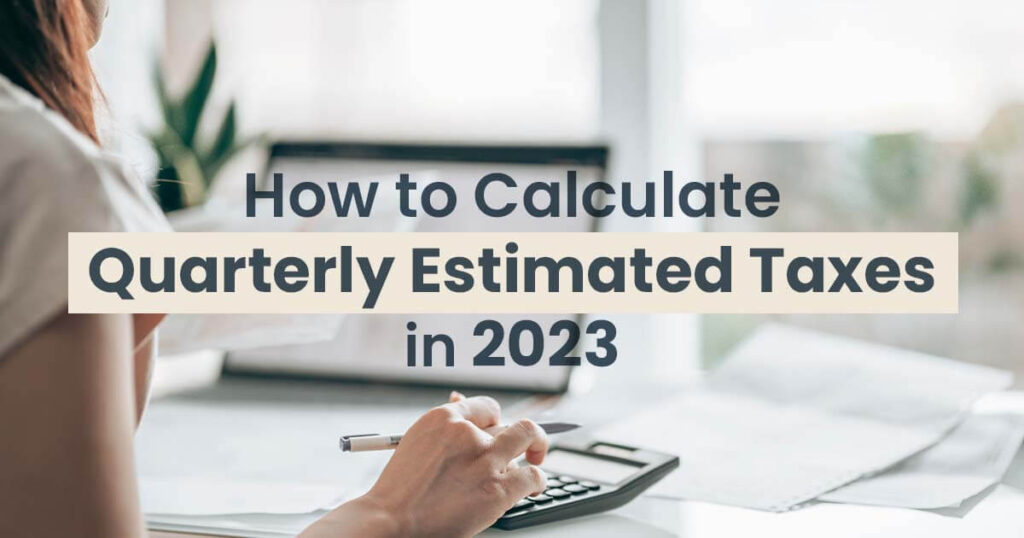Managing taxes can be one of the most challenging aspects of running a business due to federal tax law complexities. It’s easy for business owners to make a simple mistake, like not correctly calculating quarterly estimated taxes, which can lead to a potential audit. Most individuals are familiar with the tax payment process for employees, where employers withhold a part of their paycheck for IRS payments, and employees file their taxes using a W-2 form each spring.
However, the rules are a little different for non-employees. They are required to pay quarterly estimated taxes if they earn a certain annual income. The government expects tax payments on your income as you receive it. Without an employer to handle this for you, the responsibility falls squarely on your shoulders. You can’t wait until April to file your taxes and pay them in one lump sum. Timely payment of estimated taxes is important for most taxpayers, but it is critical for small businesses.
Continue reading to learn everything you need to know about calculating quarterly estimated taxes, so you can avoid penalties and stay organized.
What Are Estimated Taxes?
Business owners and freelancers pay the IRS using estimated taxes instead of withholding. Four times a year, workers or business owners that receive tax forms other than a W-2 are expected to make a tax payment directly to the IRS. This effectively replaces the tax withheld for many individuals by their employers.
Estimated taxes apply to any kind of taxable income that comes to you directly without any tax withheld, including:
- Interest
- Stock dividends
- Capital gains
- Any income you earn through self-employment
If you are starting a new business or currently own one, you must learn about the various tax requirements. Understanding your tax burden is the first step to avoiding legal penalties and fees.
How Do I Calculate Estimated Taxes?
Small business owners use IRS Form 1040-ES to calculate annual estimated taxes. We recommend speaking to an accountant or tax preparer if you’re unsure how to estimate your taxes.
There are three steps to calculating estimated payments. The steps involve calculating your taxable income based on your marital status and income, computing any credits and deductions you may get, such as child tax credits or credits for taxes already withheld, and calculating your remaining tax due.
1. Calculate Total Taxable Income
The first step is to figure out approximately how much you will make in a year or your total estimated income. You can use the full amount you expect to make in the year or the exact amount you make each quarter.
Estimating the total amount is simple for entrepreneurs and small business owners with a steady yearly income. For freelancers with unpredictable cash flow from quarter to quarter, it might make more sense to tally your actual income at the end of each quarter and pay taxes on that exact amount instead.
Either way, consider any deductions you plan to claim to calculate your Adjusted Gross Income (AGI). If you don’t consider deductions, you’ll pay much more than required.
2. Take Taxes into Account
Once you know your AGI, a crucial step in estimating your tax burden is to ensure you account for income tax and self-employment tax.
Calculate your income tax by multiplying your AGI by your tax rate using your income tax bracket. Tax brackets change year-to-year, so make sure you use the correct rate.
Those who make more than $400 a year must also pay self-employment taxes. The self-employment tax rate includes 2.9% for Medicare and 12.4% for Social Security.
Multiply your estimated total income (not your AGI) by 92.35% to calculate your taxable income for the self-employment tax. Then, multiply the result by 15.3% to calculate what you owe for self-employment.
3. Total and Divide
You’ve calculated your estimated income, taken deductions into account, and calculated your income and self-employment taxes. Now it’s time to add everything together and divide it into quarterly payments. If you calculate the exact amount each quarter, you can skip the division.
Income Taxes Owed + Self-Employment Taxes Owed = Total Estimated Taxes
Total Estimated Taxes/4 = Quarterly Tax Payment
Note: If you live in a state that levies a personal income tax, you’ll need to calculate your state tax burden when estimating your tax payments.

Should You Pay in Equal Amounts?
For most people who pay quarterly estimated taxes, it’s easiest to pay in four equal amounts when using the formula above.
However, there are some situations where you may end up paying more in certain quarters than others:
- Your previous year’s overpayment credited to your current year’s estimated tax payments
- You miss paying your first estimated payment until after April 15, when the first one is due
- You make more than expected in one quarter
What Is the Safe Harbor Rule for Estimated Tax Payments?
Due to the difficulty of estimating quarterly payments, the IRS implements a safe harbor provision that helps people avoid penalties for inaccuracy. The safe harbor rule provides a cushion for people that paid at least 90% of their bill for the previous tax year. So if you paid 90% of your final bill in estimated taxes and made your payments on time, you would be exempt from paying a penalty.
When Are the Due Dates for Quarterly Estimated Tax Payments in 2023?
Estimated tax payments are due to the IRS once per quarter of the financial year.
Here are the 2023 tax quarter deadlines:
| Tax Quarter | Quarter Dates | Deadline |
| Q1 | January 1 – March 31, 2023 | April 18, 2023 |
| Q2 | April 1 – May 31, 2023 | June 15, 2023 |
| Q3 | June 1 – August 31, 2023 | September 15, 2023 |
| Q4 | September 1 – December 31, 2023 | January 16, 2024 |
*If you file your 2023 tax return by January 31, 2024, and pay the entire balance due with your return, you do not have to make the quarterly payment due on January 17, 2023.
If your earnings predictions are reliable, you can pay your estimates early. As long as the payments aren’t late, you can combine them and pay them together at an earlier due date. IRS form 1040-ES explains the estimated tax requirements for individuals.
How Can I Pay Estimated Taxes?
You can file using the voucher with Form 1040-ES and a check or pay online using the IRS website.
There is no fee if you pay online directly from your bank account. If you choose to pay with a credit or debit card, there are fees from $2.20 – $2.55 or percentages from 1.87% – 1.98% of your payment.
Who Owes Estimated Taxes?
Most self-employed individuals and businesses have to pay estimated taxes. However, depending on your circumstances, it might not be mandatory.
The primary determining factor is how much you will owe in total. If you owe $1,000 or more on your tax return, including any estimated payments you’ve already made, you must continue making quarterly tax payments.
Exception: Farmers and Fishermen
According to the IRS, if you’re a farmer or fisherman and you follow the calendar year for tax purposes (tax year starts on January 1), and at least two-thirds of your income in 2022 or 2023 is from farming or fishing, your only payment due date is January 16, 2024. The first three payment periods aren’t applicable to you. You can find more details in Publication 505, Tax Withholding and Estimated Tax, under the ‘Farmers and Fishermen’ section.
If you don’t pay enough in estimated taxes for 2023, you could be subject to a penalty. You can figure out this penalty by comparing the total amount of tax you paid (including withholding and estimated tax) by January 16, 2024, to the smaller of these two amounts:
- 66.67% (not 90%) of your total 2023 tax, or
- The total amount of tax from your 2022 return.
The good news is, if the tax shown on your 2023 return minus what you’ve already paid in withholding is less than $1,000, you will not be penalized.
Also, if you submit your 2023 Form 1040 by March 1, 2024, and pay all the taxes owed at that time, you won’t have to make an estimated tax payment.
Farmers and fishermen who don’t start their tax year on January 1 have two options:
- Pay all your estimated taxes by the 15th day after the end of your tax year
- Submit your tax return and pay all the tax you owe by the first day of the third month after the end of your tax year.
Do I Have to Pay Estimated Taxes?
In some circumstances, an employer might withhold from your primary income, but perhaps you’ve made other income as well. You do not have to make estimated tax payments if your estimated tax and withholding so far will make up at least 90 percent of the total tax you owe for the year.
You might also use your tax return from the previous year to gauge your liability. You don’t need to pay more in advance if you have already paid as much as the total taxes you owed last year. This is known as the Safe Harbor rule.
However, you will need to pay slightly more if your income is higher. If your AGI is over $150,000, then you need to have paid 110 percent of your previous year’s tax total to not worry about paying estimated taxes. If your filing status is married, but you’re filing separately from your spouse, then your taxable income only needs to be over $75,000 to make the higher barrier necessary.
What Is the Penalty for Not Paying Quarterly Taxes?
Missing a quarterly tax payment deadline could lead to extra costs and fees for business owners. As soon as you realize you’ve missed a deadline, you should pay your quarterly taxes immediately, rather than waiting for the next payment cycle. The IRS implements penalties for late or underpayments, which are applied when filing your annual tax return.
The IRS’s penalties are based on how much you’ve underpaid and the lateness of your payment. This penalty is then added to what you owe when you file your annual tax return, which increases your business’s total tax liability. The IRS prefers to receive your owed taxes quarterly, rather than a lump sum at the end of the year. Even a minor delay, such as missing a deadline by a few days, can trigger these additional costs.
Understanding tax obligations can be challenging and stressful. Nevertheless, making on-time and sufficient payments throughout the year is crucial. It can help you avoid the penalties associated with not paying quarterly taxes, and it also prevents further complications.
How to Make Quarterly Estimated Taxes Easier
Quarterly estimated taxes may seem intimidating at first glance. However, there are some things you can do to make them easier.
-
- If you are married and filing jointly and your AGI is less than $150,000, you can make a payment equal to 100% of what you paid in income taxes the previous year. Or,
- You can pay 90% of the tax you estimate for the current year and avoid a penalty.
- At the beginning of each year, calculate your estimated payments.
- Then, put together a savings plan, so you’re not caught off guard when it comes time to make a payment.
If you’re worried about meeting the requirements or don’t have the time to figure it out, consider getting help from the professionals at Taxoto. Working with an accountant will help your business save money and avoid penalties. It will also give you more time to focus on the work that matters most — growing and expanding your business. Get help now!



